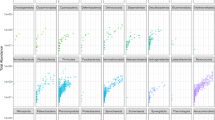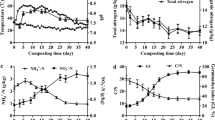Abstract
Composts contain a large and diverse community of microorganisms that play a central role in the decomposition of organic matter during the composting process. However, microbial communities active in composts have not been well described in the past. In the present study, the phylogenetic diversity of bacterial communities in livestock manure compost was determined based on terminal restriction fragment length polymorphisms (T-RFLP) of 16S rRNA genes. This technique uses a PCR in which one of the primers is fluorescently labeled. After amplification, the PCR product is then digested with restriction enzymes such as HhaI, MspI, and RsaI to generate T-RFLP fingerprints of bacterial communities. In the present study, a mixture of dairy and horse manure (dairy+horse manure; 1:1 ratio w/w) was composted in windrows and in-vessel to investigate compost bacterial diversity. The DNA was isolated from the feedstocks (day 0) and after 21 and 104 days of in-vessel and windrow composting, respectively, for T-RFLP analysis. A variety of techniques were then used to analyze T-RFLP data to gain insights about the structure of the bacterial community from these compost samples. Results of the T-RFLP analysis revealed high species diversity in the feedstocks sample As many as 27 to 39 different terminal restriction fragments (T-RFs) were found in these samples, revealing high diversity in the livestock manure composts. After composting, an increase in the T-RFLP-based Shannon diversity index was observed in the in-vessel compost, while a decrease was found in the windrow compost. Differences in chemical properties were also observed in the windrow and in-vessel composts. The windrow compost had lower water, organic matter (OM) and C contents and higher C and OM loss than the in-vessel compost.
Access this chapter
Tax calculation will be finalised at checkout
Purchases are for personal use only
Preview
Unable to display preview. Download preview PDF.
Similar content being viewed by others
References
Atlas RM, Bartha R (1997) Microbial ecology: fundamentals and applications, 4th edn. Benjamin/Cummings, Menlo Park, California, 694 pp
Beffa T, Blanc M, Marilley L, Fischer JL, Lyon,PF, Aragno M (1996) Taxonomic and metabolic microbial diversity during composting. In: De Bertoldi M, Sequi P, Lemmes B, Papi T (eds) The science of composting. Part I. M. Chapman and Hall, London, pp 149 - 161
Blanc M, Beffa T, Aragno M (1996) Biodiversity of thermophilic bacteria isolated from hot compost piles. In: De Bertoldi M, Sequi P, Lemmes B, Papi T (eds) The science of composting. Part II. Chapman and Hall, London, pp 1087 - 1090
Clement BG, Kehl LE, DeBord KL, Kits CL (1998) Terminal restriction fragment patterns ( TRFLPs), a rapid, PCR-based method for the comparison of complex bacterial communities. J Microbiol Methods 31: 135-142
Epstein E (1997) The Science of Composting. Technomic Publishing, Lancaster, Pennsylvania, 487 pp
Fujio Y, Kume SJ (1991) Isolation and identification of thermophilic bacteria from sewage sludge compost. J Ferment Bioeng 72: 334 - 337
Golueke CG (1972) Composting: a study of the process and its principles. Rodale Press, Emmaus, Pennsylvania, 110 pp
Hammer PL, Rudeanu S (1968) Boolean methods in operation research and related areas. Spinger, New York 329 pp
Heuer H, Smalla K (1997) Application of denaturing gradient gel electrophoresis and temperature gradient gel electrophoresis for studying soil microbial communities. In: Van Elsas JD, Trevors JT, Wellington EMH (eds) Modern Soil Microbiology. Marcel Dekker, New York, pp 352 - 373
Keener HM, Elwell DL, Reid GL, Michel FC Jr (2000) Composting non-separated dairy manure-theoretical limits and practical experience. Proc 8th Int Symp on Animal, Agricultural and Food Processing Wastes (ISAAFPW 2000 ). Des Moines, Iowa
Kerkhof L, Santoro M, Garland J (2000) Response of soybean rhizosphere communities to human hygiene water addition as determined by community level physiological profiling (CLPP) and terminal restriction fragment length polymorphism ( TRFLP) analysis. FEMS Microbiol Lett 184: 95-101
Liu WT, Marsh T, Cheng H, Forney LJ (1997) Characterization of microbial community by determining terminal restriction fragment length polymorphisms of genes encoding 16S rRNA. Appl Environ Microbiol 63: 4516 - 4522
Ludemann H, Arth I, Liesack W (2000) Spatial changes in bacterial community structure along a vertical oxygen gradient in flooded paddy soil cores. Appl Environ Microbiol 66: 754 - 762
Maidak BL (2000) The Ribosomal Database Project II. Abstract presented at the Midwest Molecular Ecology 2000 Conference. July 16-18, 2000, Northern Illinois University, Illinois, p 16
Marsh TL, Saxman P, Cole J, Tiedje J (2000) Terminal restriction fragment length polymorphism analysis program, a web-based research tool for microbial community analysis. Appl Environ Microbiol 66: 3616 - 3620
Massol-Deya AA, Odelson DA, Hickey RF, Tiedjie JM (1995) Bacterial community fingerprinting of amplified 16S and 16-23S ribosomal gene sequences and restriction endonucleases analysis (ARDRA). Mol Microb Ecol Man 3: 3: 2: 1 - 8
Pielou EC (1969) An introduction to mathematical ecology. Wiley, New York
Schwieger F, Tebbe CC (1998) A new approach to utilize PCR-single-strand-conformation polymorphism for 16S rRNA gene based microbial community analysis. Appl Environ Microbiol 64: 4870 - 4876
Shannon CE, Weaver W (1949) The mathematical theory of communication. University of Illinois Press, Urbana, Illinois, 125 pp
Sparks DL (1996) Nitrogen-total. In: Methods of soil analysis. Part 3- Chemical methods. SSSA, Madison, Wisconsin
Strom PF (1985a) Identification of thermophilic bacteria in solid waste composting. Appl Environ Microbiol 50: 906 - 913
Strom PF (1985b) Effect of temperature on bacterial species diversity in thermophilic solid-waste composting. Appl Environ Microbiol 50: 899 - 905
Suzuki MT, Giovanni SJ (1996) Bias caused by template annealing in the amplication of mixtures of 16S rRNA genes by PCR. Appl Envrion Microbiol 62: 625 - 630
Tiquia SM, Tam NFY, Hodgkiss IJ (1996) Microbial activities during composting of spent pig-manure sawdust litter at different moisture contents. Biores Technol 55: 201 - 206
Wiener N (1948) Cybernetics or control and communication in the animal and the machine. The Massachusetts Institute of Technology Press, Cambridge, Massachusetts, 191 pp
Author information
Authors and Affiliations
Editor information
Editors and Affiliations
Rights and permissions
Copyright information
© 2002 Springer-Verlag Berlin Heidelberg
About this paper
Cite this paper
Tiquia, S.M., Michel, F.C. (2002). Bacterial Diversity in Livestock Manure Composts as Characterized by Terminal Restriction Fragment Length Polymorphisms (T-RFLP) of PCR-amplified 16s rRNA Gene Sequences. In: Insam, H., Riddech, N., Klammer, S. (eds) Microbiology of Composting. Springer, Berlin, Heidelberg. https://doi.org/10.1007/978-3-662-08724-4_6
Download citation
DOI: https://doi.org/10.1007/978-3-662-08724-4_6
Publisher Name: Springer, Berlin, Heidelberg
Print ISBN: 978-3-642-08705-9
Online ISBN: 978-3-662-08724-4
eBook Packages: Springer Book Archive




